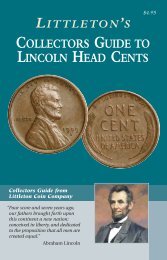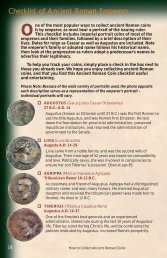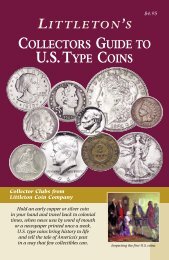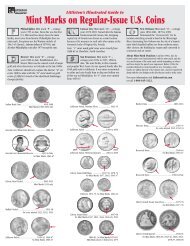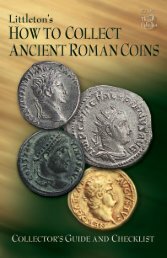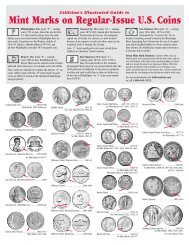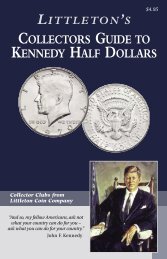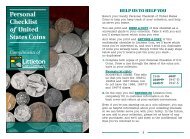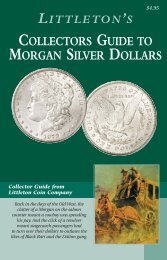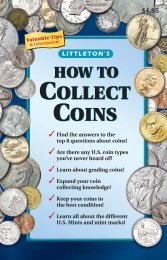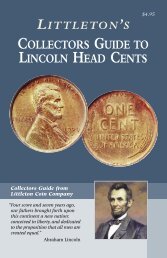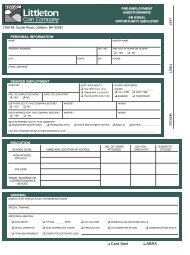Collecting Paper Money - Littleton Coin Company
Collecting Paper Money - Littleton Coin Company
Collecting Paper Money - Littleton Coin Company
You also want an ePaper? Increase the reach of your titles
YUMPU automatically turns print PDFs into web optimized ePapers that Google loves.
the history of u.s. paper money<br />
{<br />
12|<br />
striking U.S. coins dated 1861, though now under Confederate supervision.<br />
Once the Confederate government was fully established, it resolved to<br />
solve its financial woes by issuing its own paper currency. Southerners were<br />
asked to accept it on a par with regular money or bank notes – enabling it to<br />
perform the functions of legal tender. Eventually, as the war dragged on and<br />
continued to drain the South’s finances, it was patriotism alone that gave the<br />
Confederate currency any value.<br />
The South battles inflation<br />
The expenses of<br />
the Confederate<br />
States of America<br />
continued to<br />
increase, and as<br />
the war went on,<br />
Southern currency<br />
continued to<br />
depreciate in<br />
value. Confederate<br />
president Jefferson<br />
Davis’s wife kept<br />
a diary of those<br />
trying days in the<br />
South. <strong>Paper</strong><br />
money in denominations of $5 and under was useless. The Confederate<br />
money supply was so inflated it could buy little. Mrs. Davis recalled that<br />
turkeys sold for $60 each, tea was $22 a pound, and milk was $4 a quart. One<br />
bar of soap could sell for as high as $50, and an ordinary suit of clothes cost<br />
$2,700! In spite of the inflation, the Confederate Congress continued to issue<br />
millions of dollars worth of notes.<br />
At the time of the war’s conclusion, the currency authorized by the<br />
Confederate Congress consisted of hundreds of varieties. Several states of<br />
the Confederacy (Georgia and North Carolina, in particular) issued their own<br />
money, too. As true mementos of the Civil War, genuine Confederate currency<br />
is hard to beat!<br />
The North’s war chest runs low<br />
While the Civil War was in progress, Lincoln’s administration needed<br />
increasing sums of money to wage the war. The nation lacked a central<br />
banking authority, and was relying largely on private banks – banks whose<br />
finances were not always sound.<br />
In 1863, the National Banking Act passed. This act created more money<br />
with which to fight the war. It also attempted to regulate the country’s chaotic<br />
currency system. The new act encouraged private banks to apply for federal<br />
charters, thereby making them “national banks.”<br />
National Banks to the rescue – 1863<br />
Newly chartered “national banks” used their funds to buy Union bonds (thus<br />
raising money for the war). They deposited the bonds with the Treasury in<br />
www.littletoncoin.com<br />
As the Civil War progressed, inflation in the South<br />
reached such a high level that it took as many as<br />
five of these $10 notes to buy one bar of soap!<br />
{littleton coin company



